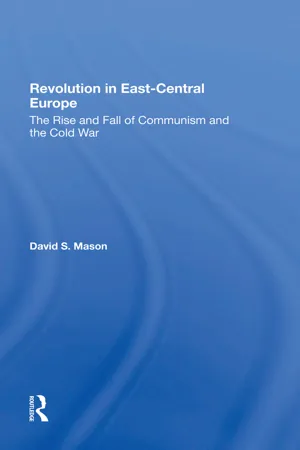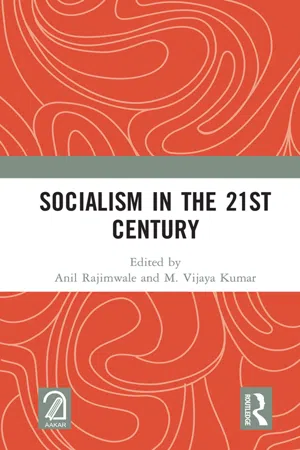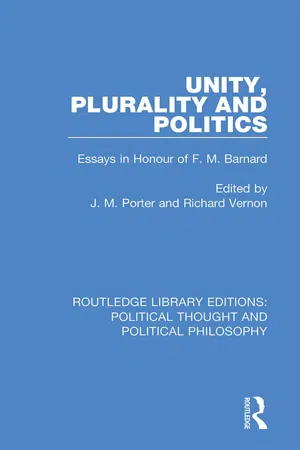Communism in Europe
Communism in Europe refers to the political and economic ideology that emerged in the early 20th century, advocating for a classless society where the means of production are owned and controlled by the community as a whole. It gained significant influence in Eastern Europe following World War II, with countries like the Soviet Union, East Germany, and Poland adopting communist governments.
6 Key excerpts on "Communism in Europe"
- eBook - ePub
- Britannica Educational Publishing, Heather Campbell(Authors)
- 2009(Publication Date)
- Britannica Educational Publishing(Publisher)
...Lenin and the Bolshevik wing of the Russian Social-Democratic Workers’ Party reinforced this distinction in 1918, the year after they seized power in Russia, by taking the name All-Russian Communist Party. Since then, communism has been largely, if not exclusively, identified with the form of political and economic organization developed in the Soviet Union and adopted subsequently in the People’s Republic of China and other countries ruled by communist parties. For much of the 20th century, in fact, about one-third of the world’s population lived under communist regimes. These regimes were characterized by the rule of a single party that tolerated no opposition and little dissent. In place of a capitalist economy, in which individuals compete for profits, moreover, party leaders established a command economy in which the state controlled property and its bureaucrats determined wages, prices, and production goals. The inefficiency of these economies played a large part in the collapse of the Soviet Union in 1991, and the remaining communist countries (excepting North Korea) are now allowing greater economic competition while holding fast to one-party rule. Whether they will succeed in this endeavour remains to be seen. Succeed or fail, however, communism is clearly not the world-shaking force it was in the 20th century. MARXISM It was neither a religious upheaval nor a civil war but a technological and economic revolution—the Industrial Revolution of the late 18th and early 19th centuries—that provided the impetus and inspiration for modern communism. This revolution, which achieved great gains in economic productivity at the expense of an increasingly miserable working class, encouraged Karl Marx to think that the class struggles that dominated history were leading inevitably to a society in which prosperity would be shared by all through common ownership of the means of production. KARL MARX (b. May 5, 1818, Trier, Rhine province, Prussia [Ger.]—d...
...CHAPTER 3 Communism in the USSR: The early years 1917–53 DOI: 10.4324/9781315836119-3 Introduction Communism in the twentieth century was dominated by the Soviet experience. Arising out of the chaos in Russia at the end of the First World War, the Bolshevik Party came to power intent on constructing Marx’s vision of communism. The pattern of socio-economic development and political power established in the USSR became a template that was exported to Eastern Europe, Asia and Africa across the twentieth century, forming a bloc of communist states. In the period between 1929 and 1956, it appeared that communism as a movement would eclipse capitalism and become the dominant global social system. How did communism come to be synonymous with the Soviet experience? The victory of Bolshevism in Russia created the world’s first state dedicated to the construction of communism. Although non-Soviet communist movements continued to exist, increasingly communism and the Soviet experience became closely tied together. As the Bolsheviks consolidated their power, they began to theorize the nature of the communist society in more detail; they began to work out how to achieve this in practice and also how this might be exported abroad. In this way, the USSR spelt out a particular interpretation of the theory and practice of Marxian communism. This is not to say that this was an authentic variant of Marxian communism, but merely that it was the Bolshevik interpretation of communism. The Bolshevik model of building a communist society has caused communism in popular consciousness to be identified with the Soviet experience. How did communism become synonymous with the USSR and Comintern? The position of the USSR as the fulcrum of the communist movement came about as a result of a series of events between 1914 and 1923...
- eBook - ePub
- Stephen White(Author)
- 2002(Publication Date)
- Routledge(Publisher)
...1 What was communism? Karl Marx told workers they ‘had no country’: in other words, they had a common interest more important than the national loyalties that might otherwise have divided them. In 1917 the world’s first socialist state was established in the USSR on the basis of his teachings. And for more than seventy years, latterly in association with a group of states in Eastern Europe and Asia, it was governed on the basis of Marx’s belief that human labour was the only source of wealth, that productive resources should be owned by the people as a whole, and that the working class in capitalist as well as socialist countries would recognise their common interest in a form of shared ownership that would eventually extend across state boundaries. It was the longest attempt that has so far been made to place ‘an ideology in power’. What, in broad terms, was this ideology? And what role did it perform in the states that were committed to it? COMMUNISM IN POWER Until the late 1980s the USSR and the countries of Eastern Europe were ruled by communist parties formally dedicated to Marxism–Leninism. Together, they were known as the ‘socialist community’, and they formed a part of a wider group of communist-ruled countries that was officially known as the ‘world socialist system’ (see Table 1.1). The largest and longest-established of these states was the Union of Soviet Socialist Republics (USSR). Like its counterparts elsewhere, all aspects of public life in the USSR were dominated by a ruling party; and, as elsewhere, it was a single party that was committed to the establishment of a fully communist society. Under its constitution, the USSR’s highest goal was the ‘building of a classless communist society’; its political system was a ‘socialist all-people’s state’; its economic system was based on socialist ownership of the means of production of a kind that could not be used for personal gain or ‘other selfish ends’...
- eBook - ePub
Revolution In East-central Europe
The Rise And Fall Of Communism And The Cold War
- David S Mason(Author)
- 2019(Publication Date)
- Routledge(Publisher)
...The lines had hardened on both sides of the iron curtain. The Institutions of Communism Over the next five years, from 1948 to 1953, the communist governments of the region proceeded to establish in their own countries the institutions and policies of Soviet-style communism. This was a time of very rapid change. The Eastern European states accomplished in five years what had taken perhaps twenty years to accomplish in the Soviet Union under Vladimir Lenin (1917-1923) and then Joseph Stalin (1920s through 1953). In part, this was possible because the Eastern Europeans had a ready-made model based on the Soviet experience, and they simply imitated the Soviet pattern in the economic, social, and political spheres. The social policies of the new regimes had elements that were both benevolent and oppressive. Like most modernizing governments, and all socialist ones, the new governments (even in the coalition phase) seized most of the large landed estates and redistributed the property to ordinary peasants and farmers. In some areas, for example in the "Western Territories" of Poland, newly acquired from Germany, this involved a huge amount of land. The government's distribution of this property, often to refugees from farther east, understandably fostered considerable goodwill toward the regime. On the one hand, the new communist-dominated governments also pursued socialist social policies that were often well-received by the population: subsidized housing, health care, education, and guaranteed employment. On the other hand, these more generous policies were accompanied by the restrictive apparatus of the Soviet state as well: an increasingly powerful secret police; restrictions on independent organizations and media; and censorship. Economically, each of the Eastern European states pursued the twin policies of rapid industrialization and collectivization of agriculture (the linchpins of Stalin's first Five-Year Plan begun in 1928)...
- eBook - ePub
- Anil Rajimwale, M. Vijaya Kumar, Anil Rajimwale, M. Vijaya Kumar(Authors)
- 2020(Publication Date)
- Routledge(Publisher)
...Lenin and propounded by Marx and Engels. Lenin had prepared the theoretical grounds of the revolution saying that semi-feudal and semi-industrialised Russia was a weak link in the imperialist stage of capitalism in the world. He had calculated that the “weak link” could be broken easily, and hence led the revolution. It was considered to be the greatest revolution in human history and was taken as the beginning of a new age where capitalism would have met its end and human society would have reached communism after passing through the stage of socialism. At the instance of Lenin, Communist International was formed and the world communist movement received a great impetus and inspiration. In many countries, socialist, communist and democratic parties were formed and later in East Europe, China, Vietnam, Cuba, North Korea and many other countries, socialist and proletarian revolutions took place. It was expected that the wave of communism would spread around the world, but it did not happen. In fact, instead of capitalism, there was the downfall of socialism itself. In the Soviet Union, the social system advanced forward with its achievements and shortcomings, but after seventy years, collapsed like a house of cards. The expectations and hopes of those, who had dreams of socialism and were involved in struggles to achieve it, met with a dead end. The socialist countries in East Europe too faced a similar fate along with Soviet Russia. The countries (Cuba, China, Vietnam, etc.) that could save the system can hardly be called socialist any more. This is precisely the fate of 20 th century socialism. Bourgeois authors saw it as the end of socialism and Marxism. On the other hand, even some Marxist authors have made a superficial analysis of the collapse/disintegration of the Soviet Union. Some even held just an individual, Gorbachev, responsible for the collapse...
- eBook - ePub
Unity, Plurality and Politics
Essays in Honour of F. M. Barnard
- J. M. Porter, Richard Vernon, J. M. Porter, Richard Vernon(Authors)
- 2019(Publication Date)
- Routledge(Publisher)
...6 THE RISE AND FALL OF MARXIST IDEOLOGY IN COMMUNIST COUNTRIES * Eugene Kamenka Introduction Karl Marx was the greatest thinker in the history of socialism. He gave socialism its intellectual respectability and its theoretical self-confidence. From divers sources and materials, from phrases in radical pamphlets and slogans at socialist meetings, from German philosophy, French politics and English economics, he created a socialist system of thought, a total socialist critique of modern society. He refined and systematised the language of socialism; he explained and expounded the place of socialism in history; he reconciled, or seemed to reconcile, its conflicting hopes and theoretical contradictions. His work – itself a process of self-clarification – set the seal upon the transition from the romantic revolutionism of the 1840s to the working-class movement that spanned the 1860s to 1880s. It fused into a single body of connected doctrine moral criticism and economic analysis, revolutionary activism and social science, the longing for community and the acceptance of economic rationality and industrial progress. It clothed the interests and demands of a still largely nascent and despised working class in the dignity of a categorical imperative pronounced by history itself. It laid the foundations for a critical account of the birth and development of modern society. For Marx correctly recognised the world-historical importance of the French Revolution and the Industrial Revolution. He saw that, in Europe at least, they were part and parcel of one development. He realised that they had inaugurated a new era in history, an era in which civil society – the world of industry and trade – had moved to the centre of the stage and was being driven by violent internal compulsions to ever more rapid change and expansion. Marx recognised more clearly than others the birth of modern society and the tensions and conflicts involved in its internal dynamic...





